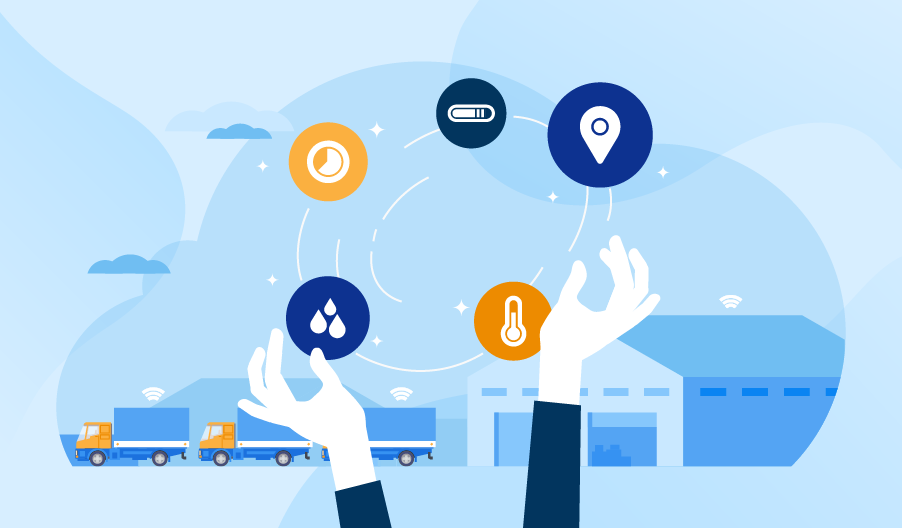IoT in Supply Chain Management and Logistics: an Overview

Editor’s note: In this article, Serge provides an overview of the Internet of Things for supply chain management and logistics, discusses the advantages of this technology, and proves its value with real-life examples. If you are looking for a modern way to manage your supply chain or logistic operations, you are welcome to consider ScienceSoft’s Internet of Things (IoT) solutions.
The Internet of Things (IoT) solutions can help significantly optimize supply chain management and logistics processes, bringing in the transparency and cost-effectiveness that cannot be achieved without the use of this advanced tech.
If you are new to IoT, here’s how it works in SCM. Internet-connected devices (e.g., image, temperature, humidity sensors, GPS trackers, etc.) enable the collection of real-time data about the goods being stored and transported, inventory level and shipment status, environmental conditions in warehouses and vehicles, etc. The raw data is then processed, stored, and analyzed in the cloud to enable continuous end-to-end monitoring of the supply chain and prompt reaction to any changes. For example, if sensors detect deviations from the predetermined temperature of cold storage facilities, the control app sends a command to adjust the temperature to the actuators and notifies supply chain operators.
Benefits IoT brings to supply chain management and logistics
Supply chain management is a multi-stage process that often involves several actors. Each actor can leverage specific benefits of IoT.
Suppliers of raw materials use IoT solutions to keep track of their technological processes, e.g., gather real-time data on crop conditions and livestock health in farming and agriculture, monitor fire accidents and logging operations in forestry, analyze oil composition within pipelines in oil extraction, etc. The data helps them increase actual output, improve the quality of raw materials, decrease energy consumption, and ensure profitability.
Manufacturers introduce IoT solutions to monitor manufacturing operations and equipment condition in real-time. Continuous supervision helps identify bottlenecks and make necessary adjustments, thus reducing downtimes, increasing asset utilization, and improving production efficiency. IoT also contributes to sustainability: tracking the power and water used, as well as monitoring emission levels can help comply with environmental regulations and implement green strategies.
IoT brings transparency and precision to logistics as logistics operators get real-time data on the location and status of every asset. With this data, they can track and optimize the entire delivery route in case of changes or delays. IoT solutions also help manage cold chains and keep perishables safe by detecting deviations from recommended transportation conditions.
The Internet of Things facilitates inventory tracking and improves the visibility and accuracy of warehousing operations. IoT solutions also contribute to preserving perishable goods through storage conditions monitoring.
Retailers benefit from the pickup and loading-unloading of goods optimized by IoT solutions, which increase picking accuracy and handling efficiency. An IoT solution can help track items across shelves, maximizing inventory visibility, and monitor store traffic to optimize the display of goods and space utilization.
How global brands transform their supply chains and logistics with IoT
Global brands quickly picked up on the benefits of IoT and started using this technology to further improve their SCM and logistics processes.
For example, Amazon enhanced its warehouse management with IoT devices that scan QR codes and identify products. Automation allowed the company to use its personnel more effectively, reduce operational costs, and improve general warehouse performance.
DHL’s IoT-enabled system provides operators with data to ensure high availability of roller cages. Another IoT initiative by DHL leverages smart heating, ventilation, and air conditioning and makes real-time adjustments based on weather conditions, building occupancy, etc., to minimize energy consumption.
Volvo and Nissan also enjoy the advantages of the Internet of Things. The former uses IoT to track vehicle shipments to international customers, while the latter implemented an IoT-based warehouse management system at its factory in the UK.
Maersk, a leading Danish shipping and logistics company, introduced a system called Remote Container Management. It monitors the temperature and humidity in shipping containers and helps operators prevent perishable cargo spoilage, reduce waste, and improve the precision of transportation scheduling.
Aker Technologies, an agtech company, offers to agriculture suppliers an IoT system that leverages drones, 3D video sensors, big data solutions, and machine learning to identify crop damage from various factors and promptly take necessary actions.
A state-of-the-art technology to help manage each stage of your supply chain
IoT enables real-time asset tracking and monitoring, provides data to facilitate advanced planning and optimization, enhances the efficiency of warehousing and transportation, and contributes to sustainability. If you are looking for a way to implement IoT for your own supply chain and logistics operations, don’t hesitate to contact ScienceSoft’s team.
See what we offer

Industrial IoT (IIoT) solutions by ScienceSoft
Are you starting an industrial digital transformation and looking for a reliable and cost-effective IIoT solution? Check out our offer!


